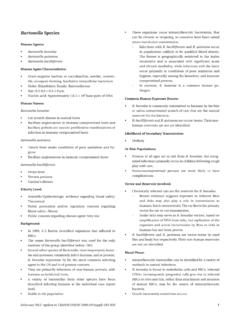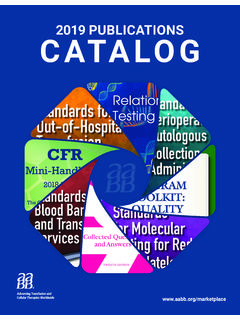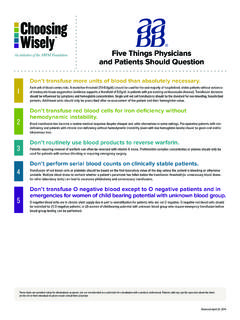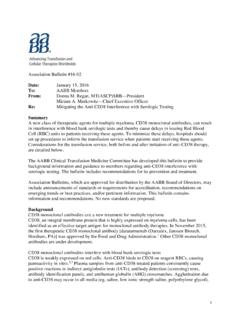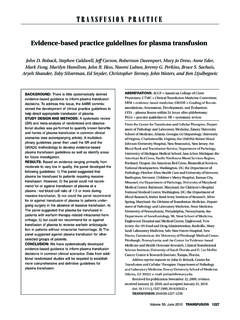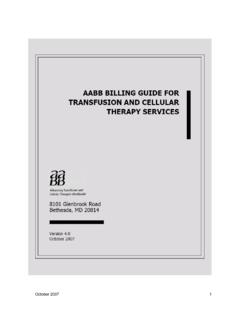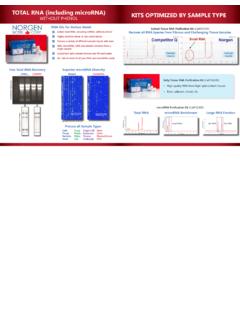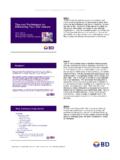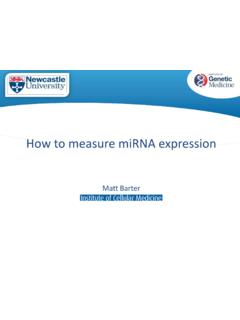Transcription of Association Bulletin #16-07 - AABB
1 1 Association Bulletin #16-07 Date: September 28, 2016 To: AABB Members From: Donna M. Regan, MT(ASCP)SBB President Miriam A. Markowitz Chief Executive Officer Re: Updated Recommendations for Zika, Dengue, and Chikungunya Viruses Summary This Association Bulletin , developed by the AABB Transfusion Transmitted Diseases Committee and reviewed and approved by the AABB Board of Directors, is intended to supersede Association Bulletins #16-06 Blood Center and Public Health Actions to Reduce the Risk of Zika Virus Transfusion Transmission and #16-04 Zika, Dengue, and Chikungunya Viruses. The intent of this new Bulletin is to clarify and update information and AABB recommendations in light of the Food and Drug Administration (FDA) guidance documents Recommendations for Donor Screening, Deferral, and Product Management to Reduce the Risk of Transfusion-Transmission of Zika Virus, published February 16, 2016 (February guidance), and Revised Recommendations for Reducing the Risk of Zika Virus Transmission by Blood and Blood Components, published August 26, 2016, (August guidance) classifying Zika virus as a relevant transfusion-transmitted infection (RTTI).
2 This Bulletin describes recommended actions before and after the implementation of the FDA recommendations contained in the August guidance, which are likely to be implemented under varying timetables by different blood centers based on the FDA recommendations. In addition, this Bulletin provides recommendations on posting of data to the AABB Zika Virus Biovigilance Network. To access the AABB Zika Virus Biovigilance Network, click here: This Bulletin also: Provides additional information on Zika virus including clinical outcomes following infection and reported cases of transfusion transmission. Discusses designation of an area as active following the recognition of reported cases of local mosquito-borne transmission in the United States as reported by the Centers for Disease Control and Prevention (CDC) on the Areas with Zika web page for blood and tissue collection centers available through the URL published in the February guidance document: The CDC subsequently updated its web pages to provide information for blood and tissue collection centers at The CDC website also provides information on Zika activity throughout the world.
3 The designation of active areas is relevant only to blood centers that have not yet implemented the August guidance. 2 Provides information and recommendations on postdonation information (PDI) relevant to Zika, dengue, and chikungunya viruses Contains minimal information for human cells, tissues, and cellular and tissue-based products (HCT/Ps). Current FDA recommendations are found in the March 7, 2016 FDA guidance document titled Donor Screening Recommendations to Reduce the Risk of Transmission of Zika Virus by Human Cells, Tissues, and Cellular and Tissue-Based Products This guidance identifies Zika virus as a relevant communicable disease agent or disease as defined in 21 CFR Part 1271.
4 Association Bulletins, which are approved by the AABB Board of Directors, may include announcements of standards or requirements for accreditation, recommendations on emerging trends or best practices, and/or pertinent information. This Bulletin contains information and AABB recommendations. No new standards are proposed. Background Epidemiology and clinical outcomes Zika, a flavivirus, is transmitted by Aedes mosquitoes, most commonly by A. aegypti. This same vector transmits dengue and yellow fever viruses (other flaviviruses) and chikungunya virus (an alphavirus). Another potential vector widely distributed in the United States that may transmit Zika virus is A.
5 Albopictus. Other routes of Zika virus transmission include intrauterine, perinatal, and sexual routes. Sexual transmission has been predominantly from infected males, but female-to-male transmission has been As of August 26, 2016, a total of 17 studies or reports have been published on sexual transmission of Zika Viral RNA has been recovered from urine, saliva, and breast milk, but transmission by these routes is Transfusion transmission has been Zika virus was first reported in Africa in 1947 from nonhuman primates, and subsequently from humans in Africa and Asia. It spread further to cause epidemics in the Pacific starting in 2007 on Yap Island in Micronesia, and an epidemic followed in 2013 in French Polynesia and other Pacific islands.
6 In May 2015, Zika virus was recognized in Brazil and local mosquito-borne transmission has later been reported in numerous countries and territories in the Western Hemisphere including Mexico and almost all countries in the Caribbean and Central and South As of August 31, 2016, active transmission has been reported in 58 areas, including 48 countries in the Americas, eight island countries in the Pacific, Cape Verde off the Western coast of Africa in the Atlantic, and Singapore ( ). Of note, as documented by the World Health Organization, 13 countries/territories have had evidence of local mosquito-borne Zika infections in or before 2015, but without documentation of cases in 2016, or with the outbreak However, it is possible that reemergence of Zika virus infection may occur in other countries in Asia.
7 In the United States, there have been several thousand travel-associated cases ( ). Vectorial transmissions have been reported in the Commonwealth of Puerto Rico, the US Virgin Islands, American Samoa, and in South Florida where, as of September 19, 2016, 85 non-travel cases have been confirmed. An apparent 3 person-to-person (non-sexual) transmission in Utah has been reported in a caregiver to a Zika In about 80 percent of individuals, infection with Zika virus is asymptomatic; in the remaining 20 percent, a mild febrile illness consisting of rash, joint pain, muscle pain, conjunctivitis, and headache are most commonly However, in adults, severe complications including Guillain-Barr and other neurological syndromes have been As of August 31, 2016, 18 countries/territories have reported Guillain-Barr associated with Zika virus Zika virus can be transmitted from an infected mother to her fetus during pregnancy and is responsible for fetal loss, microcephaly.
8 And other congenital neurological Microcephaly is one of the possible adverse outcomes among a spectrum of conditions that may be part of the congenital Zika virus syndrome. As of August 31, 2016, 20 countries/territories have reported microcephaly or other Zika-virus-related congenital Zika virus RNA has been recovered from a number of tissues including amniotic fluid, placenta, and fetal brains; in vitro, Zika virus impairs growth in human neurospheres and brain organoids, a model for the neurotropism of this Microcephaly associated with Zika virus infection in pregnant women was first described in Brazil. It is characterized by a very small skull in the affected fetus or neonate that results from interruption of growth of the brain tissue, accompanied by destruction of existing tissue, calcifications, severe cortical malformations, ventriculomegaly, cerebellar hypoplasia, and abnormal hypodensity of white matter.
9 Through rigorous analyses, congenital Zika virus infection has been demonstrated to be the causal agent of this specific, rare phenotype of Of 7830 suspected cases of congenital Zika virus syndrome reported in Brazil, investigations of 1501 live-born infants were completed by the Ministry of Health as of February 27, 2016; 602 (40 percent) were classified as definite or probable Reported rash during pregnancy (especially early pregnancy) was positively associated with a smaller head circumference and poor survival; rash was reported in approximately 40 percent of the 183 pregnant women who delivered infants with definite/probable Zika-virus-related defects, with 77 percent reporting rash during the first trimester, 18 percent during the second trimester, and 5 percent during the third trimester.
10 The finding of several newborn infants with abnormalities identified by neuroimaging despite normal-sized heads suggested that a strict definition of microcephaly for the congenital syndrome is too narrow. In another study, radiologic imaging of 438 fetuses or neonates in northeastern Brazil having suspected central nervous system impairment or having mothers who experienced a rash during pregnancy revealed brain abnormalities including ventriculomegaly and abnormalities to the corpus callosum and the cerebral cortex. Although most fetuses showed a reduced head circumference, others had a normal head circumference despite severe ventriculomegaly.


